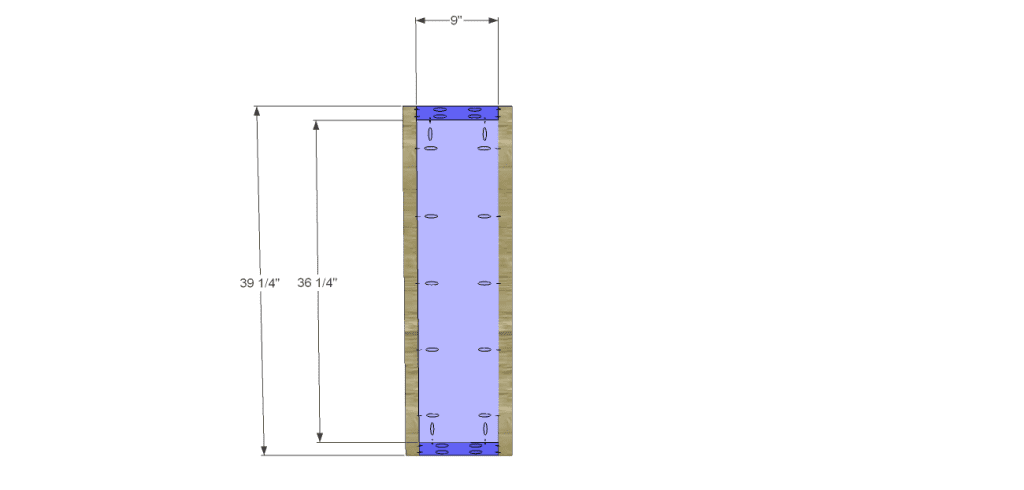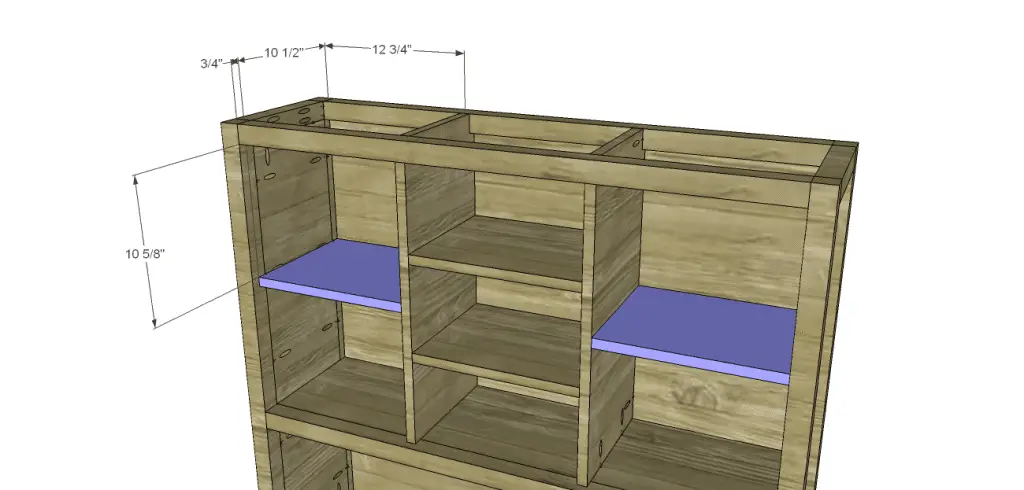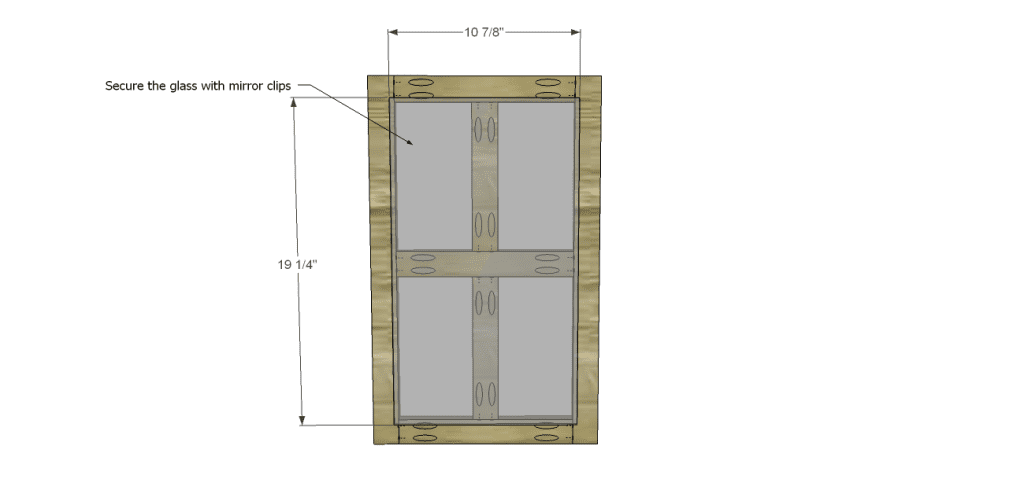Build a Hutch to Match the Sideboard
Previously, I posted plans to build the Ronen Sideboard – an easy to build piece with lots of style. Now, I’ve created plans to build the Ronen Hutch which sits atop the sideboard and takes style to the next level! With lots of storage and open shelving, the hutch is an equally easy build!

Materials:
- 1-1/4” pocket hole screws (<– affiliate link!)
- 2-1/2″ pocket hole screws
- 1-1/4” brad nails
- Edge banding, optional
- Glass for the doors – 2 at 10-7/8″ x 19-1/4″
- Mirror clips to hold the glass in place
- 2 – Angle brackets or mending plates
- 2 sets of hinges
- 2 – Cabinet pulls
- Wood glue
- Sandpaper (100, 150, 220 grits)
- Finishing supplies (primer & paint, or stain, sealer)
Lumber:
- 3 – 1×2 at 8′
- 1 – 2×2 at 4′
- 2 – 2×2 at 8′
- 1 full sheet of 3/4″ plywood
Cut List:
- 4 – 2×2 at 39-1/4″ – Side Frames
- 4 – 2×2 at 9″ – Side Frames
- 2 – 3/4″ plywood at 9″ x 36-1/4″ – Side Panels
- 4 – 2×2 at 40″ – Back Frame & Front Stretchers
- 1 – 3/4″ plywood at 36-1/4″ x 40″ – Back Panel
- 1 – 3/4″ plywood at 9-3/4″ x 40″ – Shelf
- 2 – 3/4″ plywood at 10-1/2″ x 23-1/2″ – Dividers
- 2 – 3/4″ plywood at 10-1/2″ x 13″ – Center Shelves
- 2 – 3/4″ plywood at 10-1/2″ x 12-3/4″ – Side Shelves
- 2 – 1×2 at 11-1/2″ – Top Trim Side
- 1 – 1×2 at 45″ – Top Trim Front
- 1 – 3/4″ plywood at 11-1/2″ x 42″ – Top Panel
- 6 – 1×2 at 10-3/8″ – Door Rails
- 4 – 1×2 at 21-3/4″ – Door Stiles
- 4 – 1×2 at 8-5/8″ – Shorter Door Stiles

Step One
Edge banding will be applied to the exposed edges of the plywood prior to assembly.
Cut the pieces for the side frames and the side panels. With the pocket hole jig set for 1-1/2″ material, drill pocket holes in each end of the shorter frame pieces. Secure to the longer frame pieces using glue and 2-1/2″ pocket hole screws.
Set the pocket hole jig for 3/4″ material and drill pocket holes in all four edges of the panels. Secure to the frames using glue and 1-1/4″ pocket hole screws. The back face of the panels will be flush with the back face of the frames.

Step Two
Cut the pieces for the back frame and panel. Set the pocket hole jig set for 1-1/2″ material, drill pocket holes in each end of the frame pieces. Secure to the side frame pieces using glue and 2-1/2″ pocket hole screws.
Set the pocket hole jig for 3/4″ material and drill pocket holes in all four edges of the panels. Secure to the frames using glue and 1-1/4″ pocket hole screws. The back face of the panel will be flush with the back face of the frame.

Step Three
Cut the pieces for the front stretchers. Set the pocket hole jig set for 1-1/2″ material, drill pocket holes in each end of the frame pieces. Secure to the side frame pieces using glue and 2-1/2″ pocket hole screws.

Step Four
Cut the piece for the shelf. Set the pocket hole jig for 3/4″ material and drill pocket holes in all four edges of the shelf. Secure to the lower front stretcher, sides, and back using glue and 1-1/4″ pocket hole screws. The top face of the panel will be flush with the top face of the lower stretcher.

Step Five
Cut the pieces for the dividers and cut the notches as shown using a jigsaw. Drill the pocket holes in the back and bottom edges treating the pieces as left and right. This way, the pocket holes will be hidden inside the compartments with the doors and won’t have to be filled. Secure to the back and bottom using glue and 1-1/4″ pocket hole screws.


Step Six
Cut the pieces for the center shelves. Position as shown then secure using glue and 1-1/4″ brad nails through the back and dividers into the shelves.

Step Seven
Cut the pieces for the side shelves. Position as shown, locating them 3/4″ back from the front, then secure using glue and 1-1/4″ brad nails through the sides, back, and dividers into the shelves.

Step Eight
Cut the pieces for the top and the top trim. Drill pocket holes in one end only of each of the side trim pieces as well as the sides and front of the top. Secure the side trim pieces first using glue and 1-1/4″ pocket hole screws, then secure the front trim in the same manner.
The front and sides of the top will overhang by 1″ and the back will be flush. Secure in place using glue and 1-1/4″ brad nails.


Step Nine
Cut the pieces for the doors and drill pocket holes in the pieces as shown. Assemble the frame using glue and 1-1/4″ pocket hole screws.
Position the glass over the opening and secure in place using mirror clips. Install the hinges on the doors, then install the doors in the cabinet. Install the cabinet pulls.
Secure the hutch to the sideboard using angle brackets on the inside of the sides or mending plates on the back.



Finish as desired!
The hutch would be fabulous with punched aluminum or mirrors in the door frames in place of the glass! If there are any questions about the plans to build the Ronen Hutch, let me know at cher {at} designsbystudioc {dot} com!
Originally posted 2014-04-11 08:00:45.






Comments are closed.